HRP System Development for Mitre Corporation: A Report
VerifiedAdded on 2023/04/24
|14
|3016
|463
Report
AI Summary
This report develops a human resource planning (HRP) system for Mitre Corporation by assessing its human resource needs and ensuring a continuous supply of manpower. It evaluates key components like external environment, labor demand forecast, labor supply analysis, demand and supply balance, and plan drafting. The report also critically analyzes the integration of people, process, and technology for effective HRP utilization within the organization, identifying challenges and suggesting improvements. It covers environmental assessment using PEST analysis, forecasting labor demand based on technological advancements, and balancing demand and supply through recruitment, selection, and training programs. The evaluation of people, process, and technology highlights the importance of competent leadership, a dedicated HRP team, and the use of HR information, learning management, and talent management systems for successful HRP implementation at Mitre Corporation.
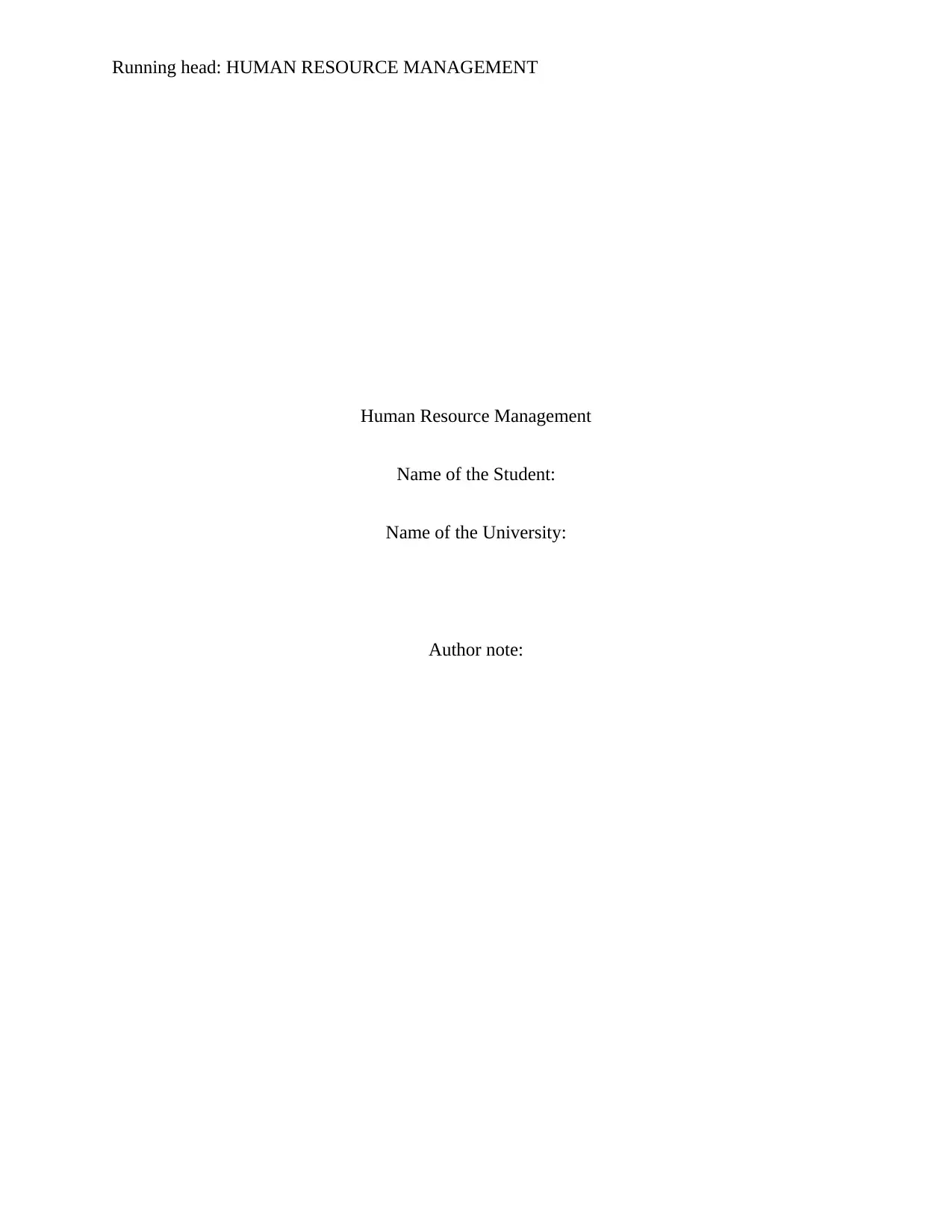
Running head: HUMAN RESOURCE MANAGEMENT
Human Resource Management
Name of the Student:
Name of the University:
Author note:
Human Resource Management
Name of the Student:
Name of the University:
Author note:
Paraphrase This Document
Need a fresh take? Get an instant paraphrase of this document with our AI Paraphraser
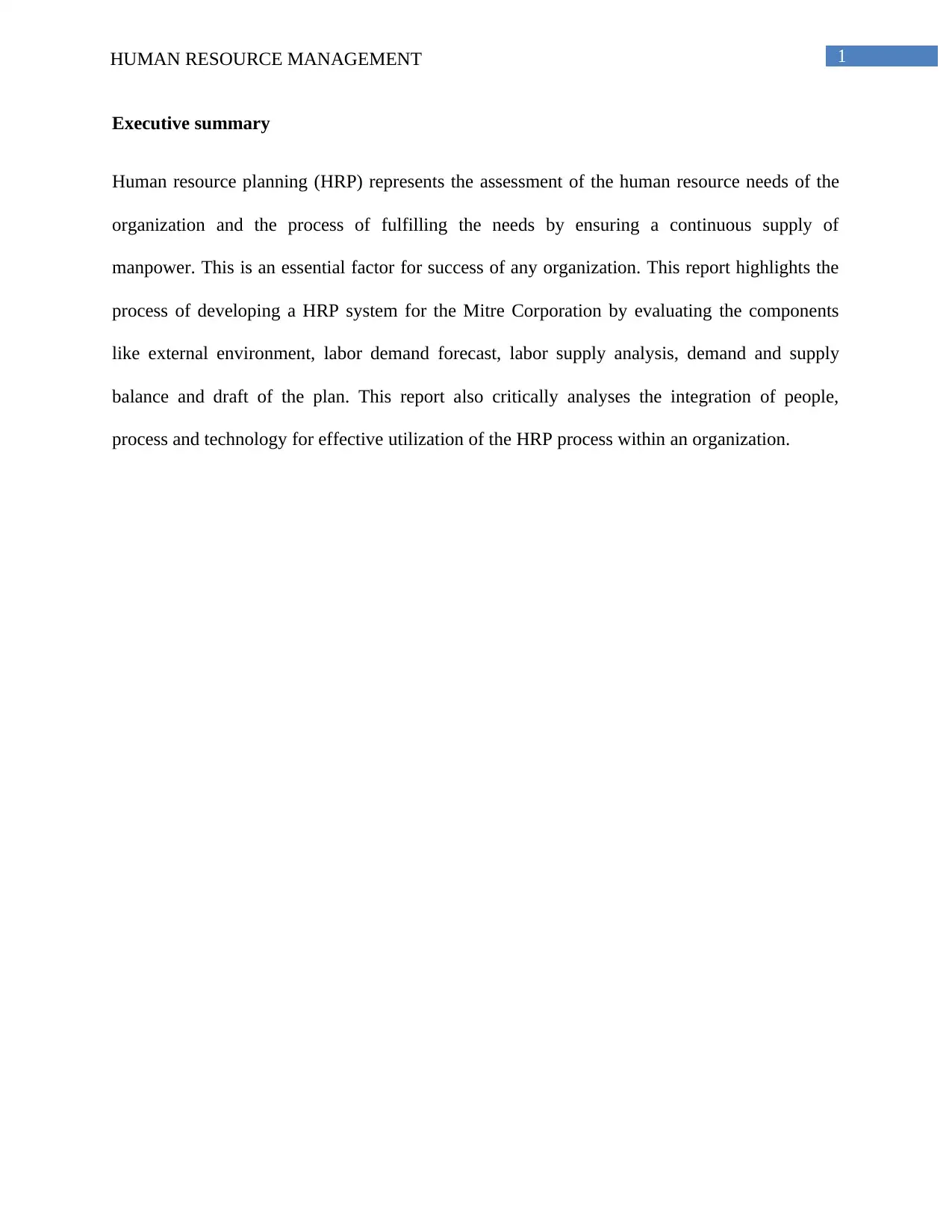
1HUMAN RESOURCE MANAGEMENT
Executive summary
Human resource planning (HRP) represents the assessment of the human resource needs of the
organization and the process of fulfilling the needs by ensuring a continuous supply of
manpower. This is an essential factor for success of any organization. This report highlights the
process of developing a HRP system for the Mitre Corporation by evaluating the components
like external environment, labor demand forecast, labor supply analysis, demand and supply
balance and draft of the plan. This report also critically analyses the integration of people,
process and technology for effective utilization of the HRP process within an organization.
Executive summary
Human resource planning (HRP) represents the assessment of the human resource needs of the
organization and the process of fulfilling the needs by ensuring a continuous supply of
manpower. This is an essential factor for success of any organization. This report highlights the
process of developing a HRP system for the Mitre Corporation by evaluating the components
like external environment, labor demand forecast, labor supply analysis, demand and supply
balance and draft of the plan. This report also critically analyses the integration of people,
process and technology for effective utilization of the HRP process within an organization.
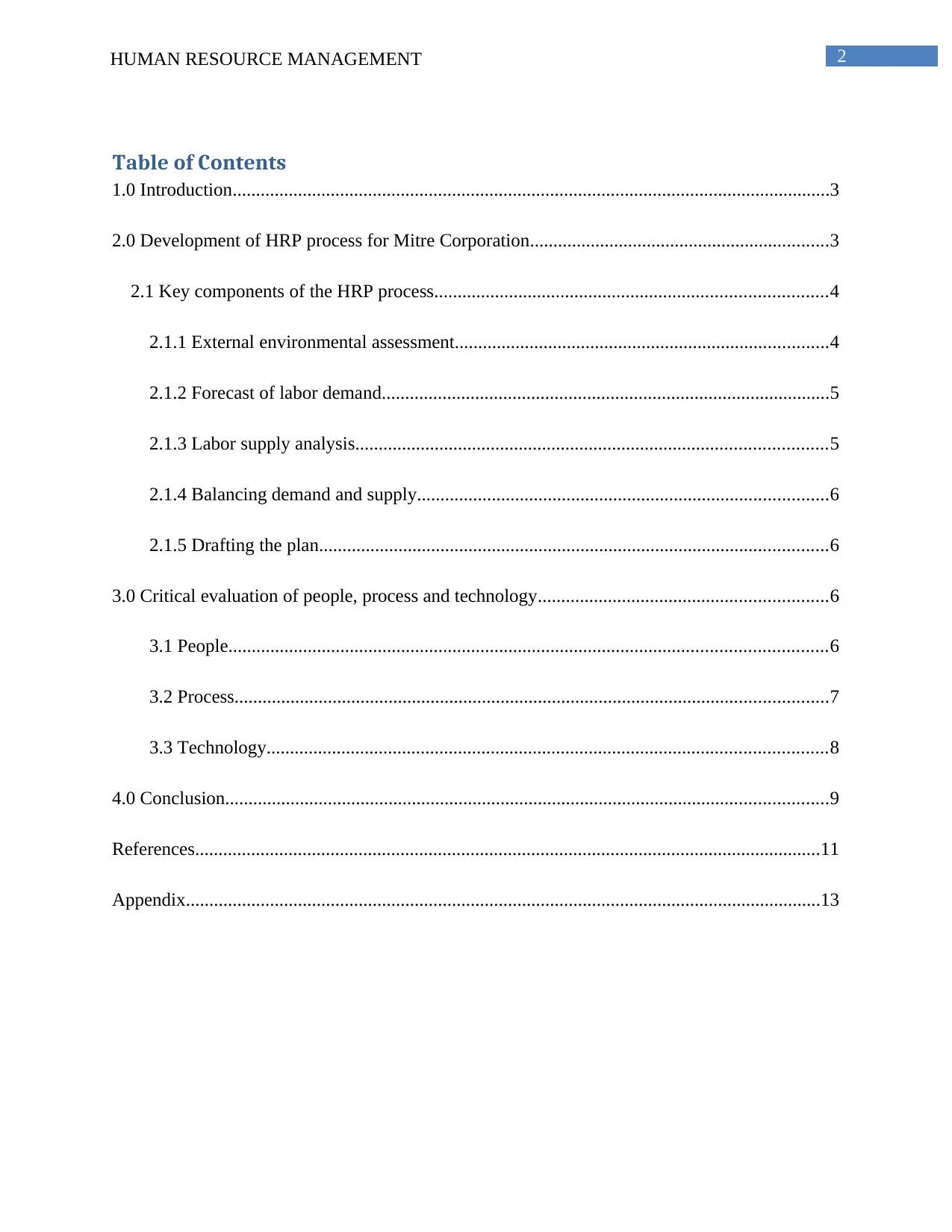
2HUMAN RESOURCE MANAGEMENT
Table of Contents
1.0 Introduction................................................................................................................................3
2.0 Development of HRP process for Mitre Corporation................................................................3
2.1 Key components of the HRP process....................................................................................4
2.1.1 External environmental assessment................................................................................4
2.1.2 Forecast of labor demand................................................................................................5
2.1.3 Labor supply analysis.....................................................................................................5
2.1.4 Balancing demand and supply........................................................................................6
2.1.5 Drafting the plan.............................................................................................................6
3.0 Critical evaluation of people, process and technology..............................................................6
3.1 People................................................................................................................................6
3.2 Process...............................................................................................................................7
3.3 Technology........................................................................................................................8
4.0 Conclusion.................................................................................................................................9
References......................................................................................................................................11
Appendix........................................................................................................................................13
Table of Contents
1.0 Introduction................................................................................................................................3
2.0 Development of HRP process for Mitre Corporation................................................................3
2.1 Key components of the HRP process....................................................................................4
2.1.1 External environmental assessment................................................................................4
2.1.2 Forecast of labor demand................................................................................................5
2.1.3 Labor supply analysis.....................................................................................................5
2.1.4 Balancing demand and supply........................................................................................6
2.1.5 Drafting the plan.............................................................................................................6
3.0 Critical evaluation of people, process and technology..............................................................6
3.1 People................................................................................................................................6
3.2 Process...............................................................................................................................7
3.3 Technology........................................................................................................................8
4.0 Conclusion.................................................................................................................................9
References......................................................................................................................................11
Appendix........................................................................................................................................13
⊘ This is a preview!⊘
Do you want full access?
Subscribe today to unlock all pages.

Trusted by 1+ million students worldwide
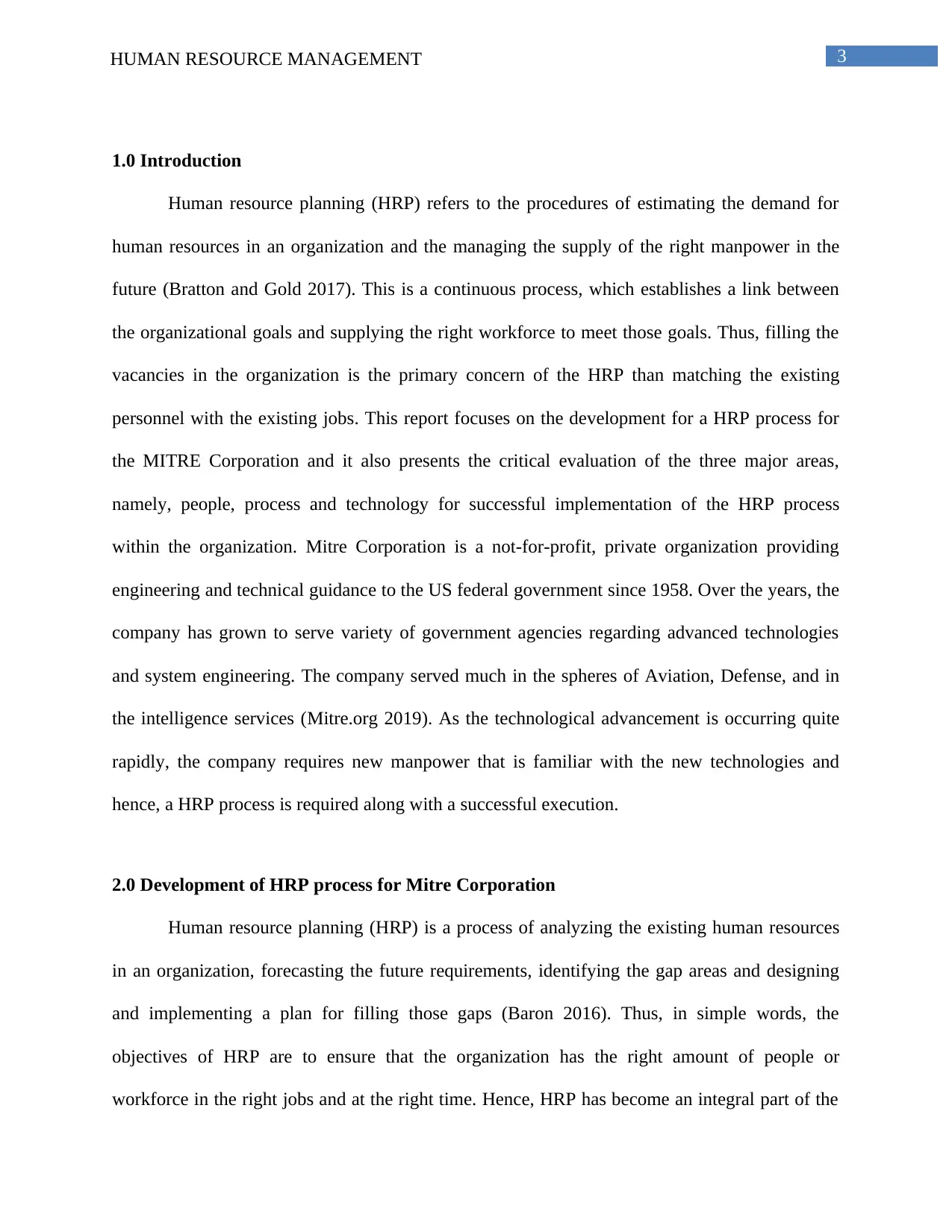
3HUMAN RESOURCE MANAGEMENT
1.0 Introduction
Human resource planning (HRP) refers to the procedures of estimating the demand for
human resources in an organization and the managing the supply of the right manpower in the
future (Bratton and Gold 2017). This is a continuous process, which establishes a link between
the organizational goals and supplying the right workforce to meet those goals. Thus, filling the
vacancies in the organization is the primary concern of the HRP than matching the existing
personnel with the existing jobs. This report focuses on the development for a HRP process for
the MITRE Corporation and it also presents the critical evaluation of the three major areas,
namely, people, process and technology for successful implementation of the HRP process
within the organization. Mitre Corporation is a not-for-profit, private organization providing
engineering and technical guidance to the US federal government since 1958. Over the years, the
company has grown to serve variety of government agencies regarding advanced technologies
and system engineering. The company served much in the spheres of Aviation, Defense, and in
the intelligence services (Mitre.org 2019). As the technological advancement is occurring quite
rapidly, the company requires new manpower that is familiar with the new technologies and
hence, a HRP process is required along with a successful execution.
2.0 Development of HRP process for Mitre Corporation
Human resource planning (HRP) is a process of analyzing the existing human resources
in an organization, forecasting the future requirements, identifying the gap areas and designing
and implementing a plan for filling those gaps (Baron 2016). Thus, in simple words, the
objectives of HRP are to ensure that the organization has the right amount of people or
workforce in the right jobs and at the right time. Hence, HRP has become an integral part of the
1.0 Introduction
Human resource planning (HRP) refers to the procedures of estimating the demand for
human resources in an organization and the managing the supply of the right manpower in the
future (Bratton and Gold 2017). This is a continuous process, which establishes a link between
the organizational goals and supplying the right workforce to meet those goals. Thus, filling the
vacancies in the organization is the primary concern of the HRP than matching the existing
personnel with the existing jobs. This report focuses on the development for a HRP process for
the MITRE Corporation and it also presents the critical evaluation of the three major areas,
namely, people, process and technology for successful implementation of the HRP process
within the organization. Mitre Corporation is a not-for-profit, private organization providing
engineering and technical guidance to the US federal government since 1958. Over the years, the
company has grown to serve variety of government agencies regarding advanced technologies
and system engineering. The company served much in the spheres of Aviation, Defense, and in
the intelligence services (Mitre.org 2019). As the technological advancement is occurring quite
rapidly, the company requires new manpower that is familiar with the new technologies and
hence, a HRP process is required along with a successful execution.
2.0 Development of HRP process for Mitre Corporation
Human resource planning (HRP) is a process of analyzing the existing human resources
in an organization, forecasting the future requirements, identifying the gap areas and designing
and implementing a plan for filling those gaps (Baron 2016). Thus, in simple words, the
objectives of HRP are to ensure that the organization has the right amount of people or
workforce in the right jobs and at the right time. Hence, HRP has become an integral part of the
Paraphrase This Document
Need a fresh take? Get an instant paraphrase of this document with our AI Paraphraser
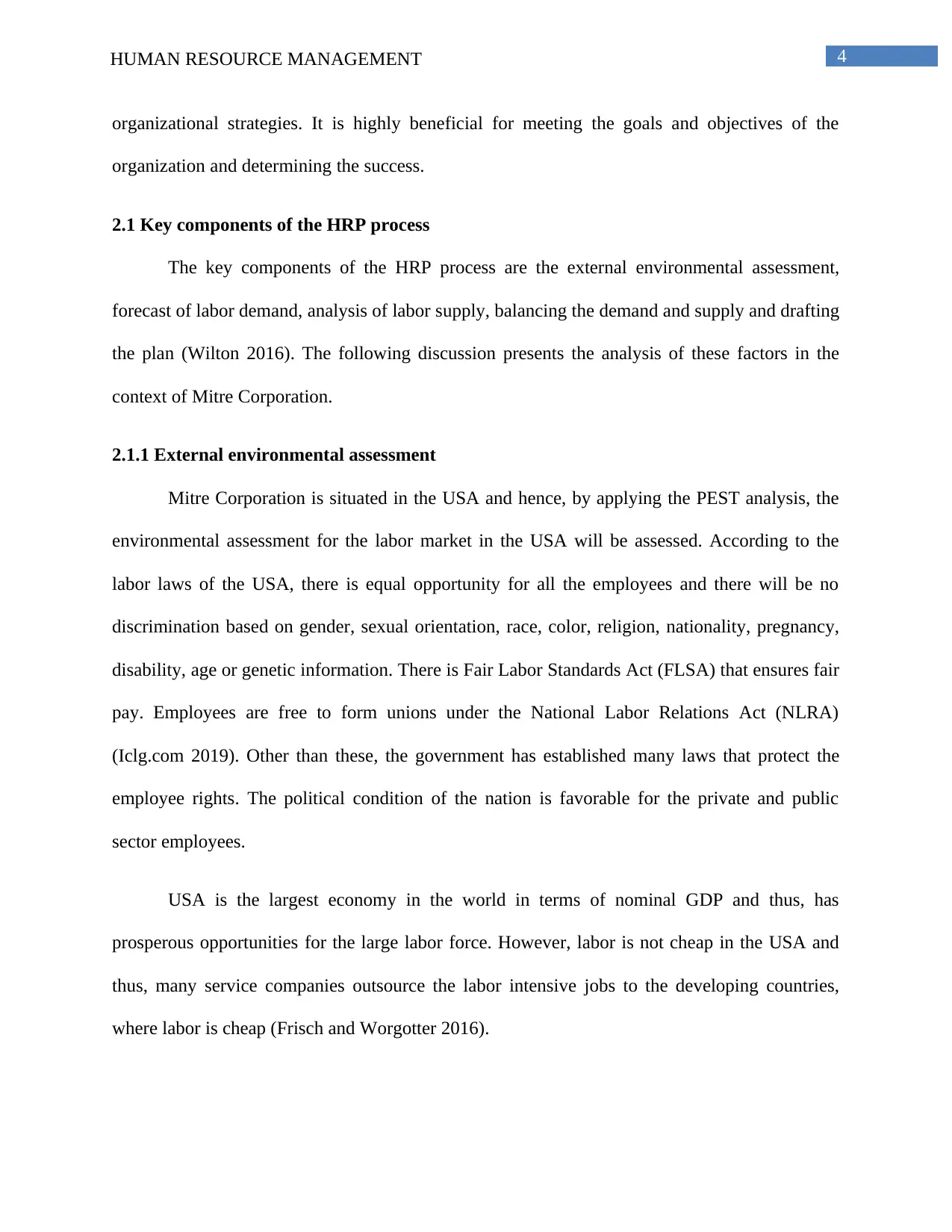
4HUMAN RESOURCE MANAGEMENT
organizational strategies. It is highly beneficial for meeting the goals and objectives of the
organization and determining the success.
2.1 Key components of the HRP process
The key components of the HRP process are the external environmental assessment,
forecast of labor demand, analysis of labor supply, balancing the demand and supply and drafting
the plan (Wilton 2016). The following discussion presents the analysis of these factors in the
context of Mitre Corporation.
2.1.1 External environmental assessment
Mitre Corporation is situated in the USA and hence, by applying the PEST analysis, the
environmental assessment for the labor market in the USA will be assessed. According to the
labor laws of the USA, there is equal opportunity for all the employees and there will be no
discrimination based on gender, sexual orientation, race, color, religion, nationality, pregnancy,
disability, age or genetic information. There is Fair Labor Standards Act (FLSA) that ensures fair
pay. Employees are free to form unions under the National Labor Relations Act (NLRA)
(Iclg.com 2019). Other than these, the government has established many laws that protect the
employee rights. The political condition of the nation is favorable for the private and public
sector employees.
USA is the largest economy in the world in terms of nominal GDP and thus, has
prosperous opportunities for the large labor force. However, labor is not cheap in the USA and
thus, many service companies outsource the labor intensive jobs to the developing countries,
where labor is cheap (Frisch and Worgotter 2016).
organizational strategies. It is highly beneficial for meeting the goals and objectives of the
organization and determining the success.
2.1 Key components of the HRP process
The key components of the HRP process are the external environmental assessment,
forecast of labor demand, analysis of labor supply, balancing the demand and supply and drafting
the plan (Wilton 2016). The following discussion presents the analysis of these factors in the
context of Mitre Corporation.
2.1.1 External environmental assessment
Mitre Corporation is situated in the USA and hence, by applying the PEST analysis, the
environmental assessment for the labor market in the USA will be assessed. According to the
labor laws of the USA, there is equal opportunity for all the employees and there will be no
discrimination based on gender, sexual orientation, race, color, religion, nationality, pregnancy,
disability, age or genetic information. There is Fair Labor Standards Act (FLSA) that ensures fair
pay. Employees are free to form unions under the National Labor Relations Act (NLRA)
(Iclg.com 2019). Other than these, the government has established many laws that protect the
employee rights. The political condition of the nation is favorable for the private and public
sector employees.
USA is the largest economy in the world in terms of nominal GDP and thus, has
prosperous opportunities for the large labor force. However, labor is not cheap in the USA and
thus, many service companies outsource the labor intensive jobs to the developing countries,
where labor is cheap (Frisch and Worgotter 2016).
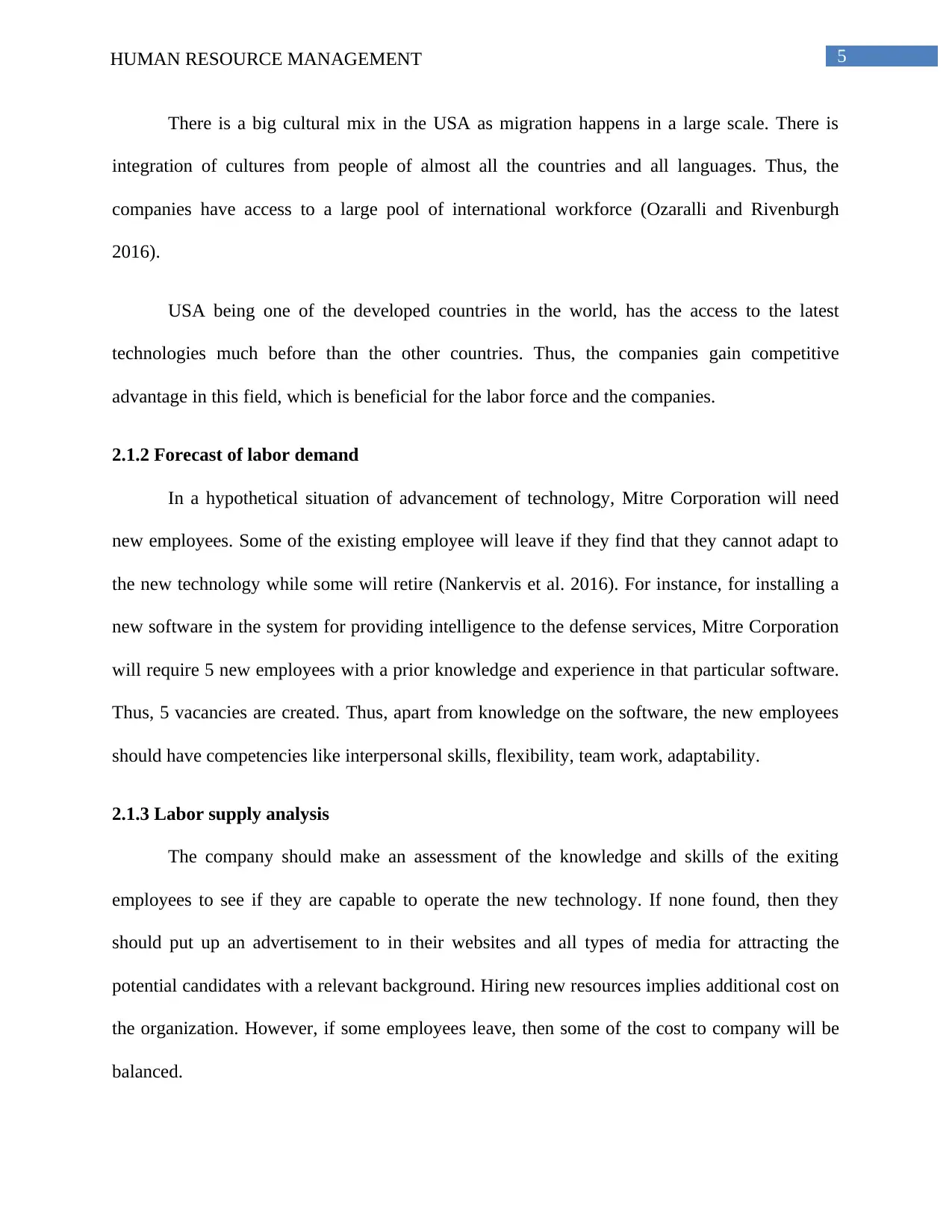
5HUMAN RESOURCE MANAGEMENT
There is a big cultural mix in the USA as migration happens in a large scale. There is
integration of cultures from people of almost all the countries and all languages. Thus, the
companies have access to a large pool of international workforce (Ozaralli and Rivenburgh
2016).
USA being one of the developed countries in the world, has the access to the latest
technologies much before than the other countries. Thus, the companies gain competitive
advantage in this field, which is beneficial for the labor force and the companies.
2.1.2 Forecast of labor demand
In a hypothetical situation of advancement of technology, Mitre Corporation will need
new employees. Some of the existing employee will leave if they find that they cannot adapt to
the new technology while some will retire (Nankervis et al. 2016). For instance, for installing a
new software in the system for providing intelligence to the defense services, Mitre Corporation
will require 5 new employees with a prior knowledge and experience in that particular software.
Thus, 5 vacancies are created. Thus, apart from knowledge on the software, the new employees
should have competencies like interpersonal skills, flexibility, team work, adaptability.
2.1.3 Labor supply analysis
The company should make an assessment of the knowledge and skills of the exiting
employees to see if they are capable to operate the new technology. If none found, then they
should put up an advertisement to in their websites and all types of media for attracting the
potential candidates with a relevant background. Hiring new resources implies additional cost on
the organization. However, if some employees leave, then some of the cost to company will be
balanced.
There is a big cultural mix in the USA as migration happens in a large scale. There is
integration of cultures from people of almost all the countries and all languages. Thus, the
companies have access to a large pool of international workforce (Ozaralli and Rivenburgh
2016).
USA being one of the developed countries in the world, has the access to the latest
technologies much before than the other countries. Thus, the companies gain competitive
advantage in this field, which is beneficial for the labor force and the companies.
2.1.2 Forecast of labor demand
In a hypothetical situation of advancement of technology, Mitre Corporation will need
new employees. Some of the existing employee will leave if they find that they cannot adapt to
the new technology while some will retire (Nankervis et al. 2016). For instance, for installing a
new software in the system for providing intelligence to the defense services, Mitre Corporation
will require 5 new employees with a prior knowledge and experience in that particular software.
Thus, 5 vacancies are created. Thus, apart from knowledge on the software, the new employees
should have competencies like interpersonal skills, flexibility, team work, adaptability.
2.1.3 Labor supply analysis
The company should make an assessment of the knowledge and skills of the exiting
employees to see if they are capable to operate the new technology. If none found, then they
should put up an advertisement to in their websites and all types of media for attracting the
potential candidates with a relevant background. Hiring new resources implies additional cost on
the organization. However, if some employees leave, then some of the cost to company will be
balanced.
⊘ This is a preview!⊘
Do you want full access?
Subscribe today to unlock all pages.

Trusted by 1+ million students worldwide
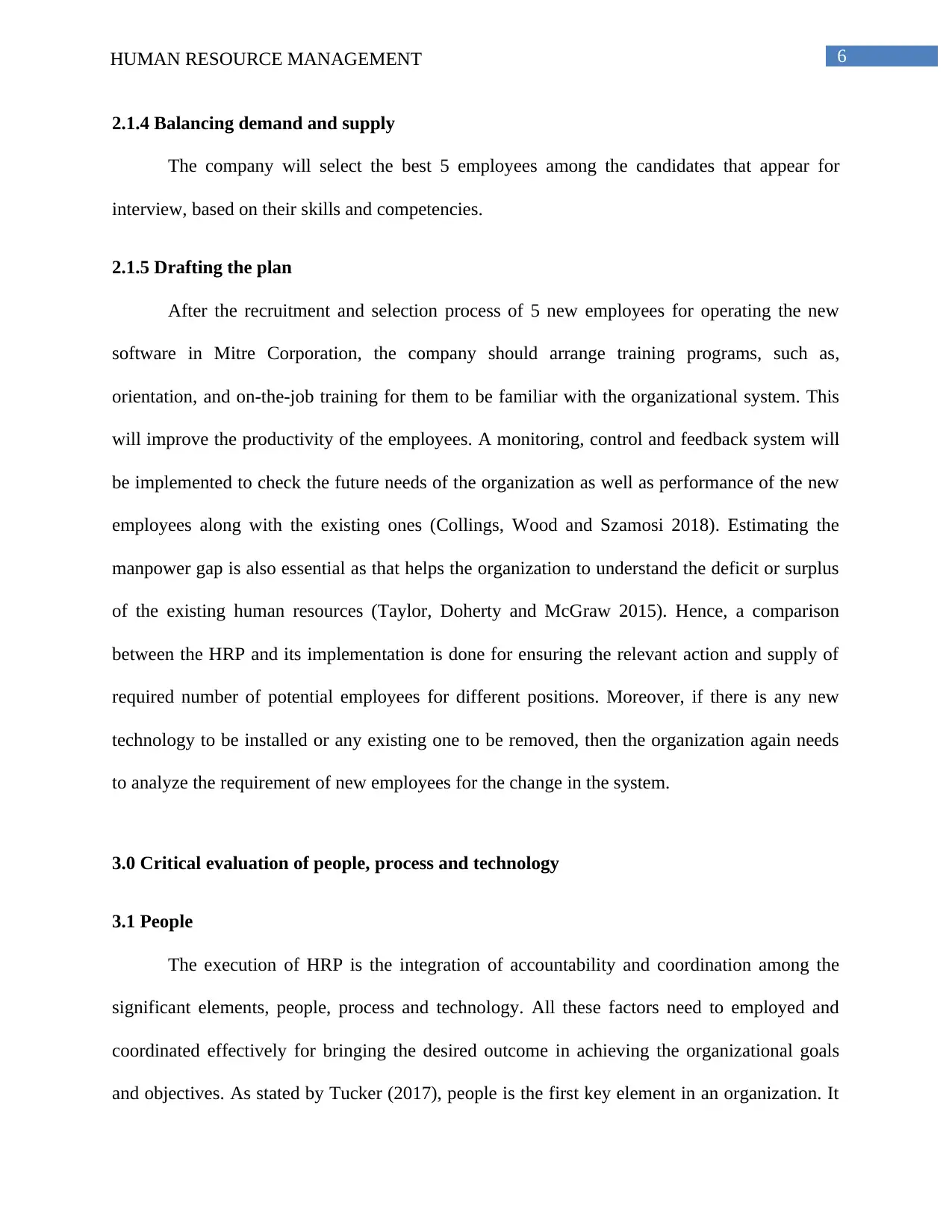
6HUMAN RESOURCE MANAGEMENT
2.1.4 Balancing demand and supply
The company will select the best 5 employees among the candidates that appear for
interview, based on their skills and competencies.
2.1.5 Drafting the plan
After the recruitment and selection process of 5 new employees for operating the new
software in Mitre Corporation, the company should arrange training programs, such as,
orientation, and on-the-job training for them to be familiar with the organizational system. This
will improve the productivity of the employees. A monitoring, control and feedback system will
be implemented to check the future needs of the organization as well as performance of the new
employees along with the existing ones (Collings, Wood and Szamosi 2018). Estimating the
manpower gap is also essential as that helps the organization to understand the deficit or surplus
of the existing human resources (Taylor, Doherty and McGraw 2015). Hence, a comparison
between the HRP and its implementation is done for ensuring the relevant action and supply of
required number of potential employees for different positions. Moreover, if there is any new
technology to be installed or any existing one to be removed, then the organization again needs
to analyze the requirement of new employees for the change in the system.
3.0 Critical evaluation of people, process and technology
3.1 People
The execution of HRP is the integration of accountability and coordination among the
significant elements, people, process and technology. All these factors need to employed and
coordinated effectively for bringing the desired outcome in achieving the organizational goals
and objectives. As stated by Tucker (2017), people is the first key element in an organization. It
2.1.4 Balancing demand and supply
The company will select the best 5 employees among the candidates that appear for
interview, based on their skills and competencies.
2.1.5 Drafting the plan
After the recruitment and selection process of 5 new employees for operating the new
software in Mitre Corporation, the company should arrange training programs, such as,
orientation, and on-the-job training for them to be familiar with the organizational system. This
will improve the productivity of the employees. A monitoring, control and feedback system will
be implemented to check the future needs of the organization as well as performance of the new
employees along with the existing ones (Collings, Wood and Szamosi 2018). Estimating the
manpower gap is also essential as that helps the organization to understand the deficit or surplus
of the existing human resources (Taylor, Doherty and McGraw 2015). Hence, a comparison
between the HRP and its implementation is done for ensuring the relevant action and supply of
required number of potential employees for different positions. Moreover, if there is any new
technology to be installed or any existing one to be removed, then the organization again needs
to analyze the requirement of new employees for the change in the system.
3.0 Critical evaluation of people, process and technology
3.1 People
The execution of HRP is the integration of accountability and coordination among the
significant elements, people, process and technology. All these factors need to employed and
coordinated effectively for bringing the desired outcome in achieving the organizational goals
and objectives. As stated by Tucker (2017), people is the first key element in an organization. It
Paraphrase This Document
Need a fresh take? Get an instant paraphrase of this document with our AI Paraphraser
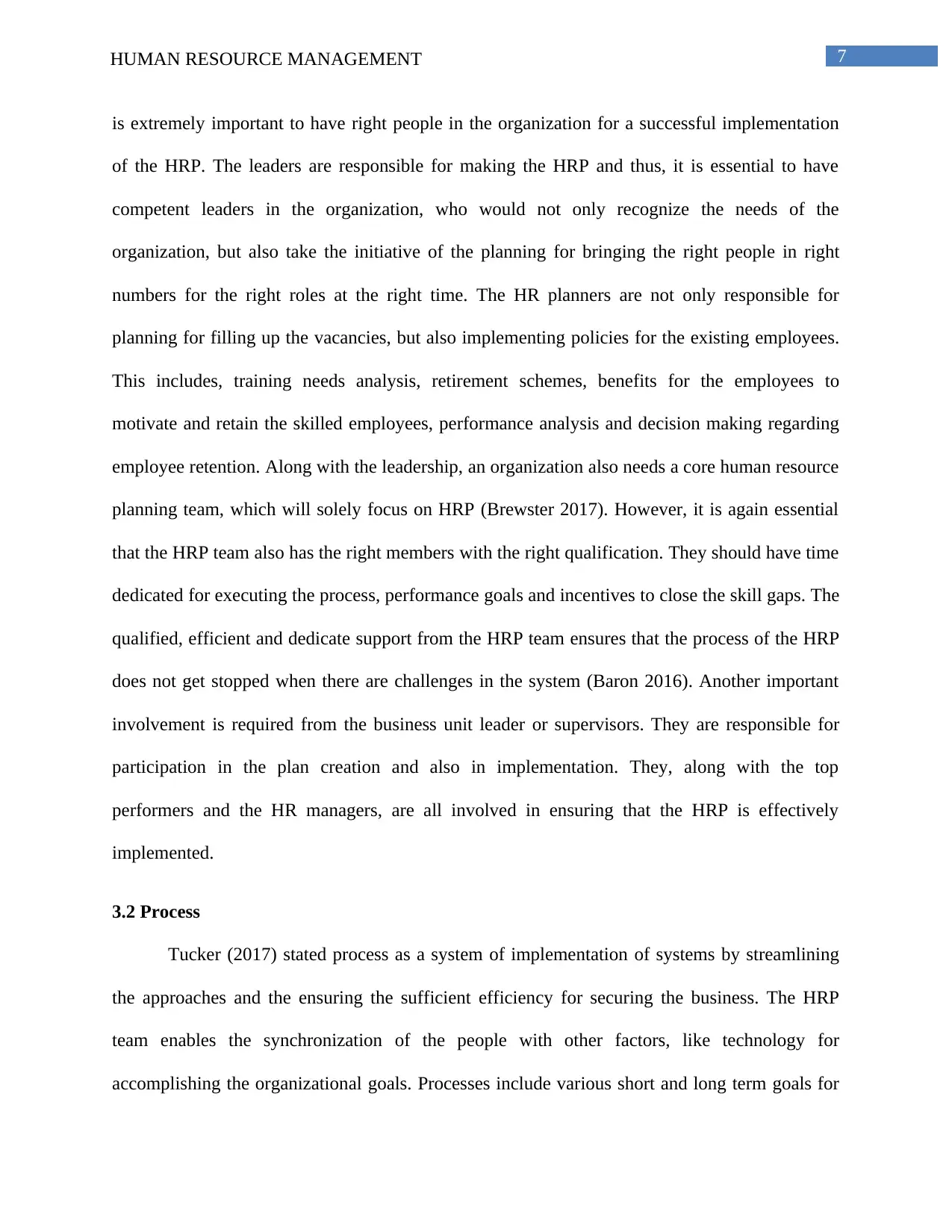
7HUMAN RESOURCE MANAGEMENT
is extremely important to have right people in the organization for a successful implementation
of the HRP. The leaders are responsible for making the HRP and thus, it is essential to have
competent leaders in the organization, who would not only recognize the needs of the
organization, but also take the initiative of the planning for bringing the right people in right
numbers for the right roles at the right time. The HR planners are not only responsible for
planning for filling up the vacancies, but also implementing policies for the existing employees.
This includes, training needs analysis, retirement schemes, benefits for the employees to
motivate and retain the skilled employees, performance analysis and decision making regarding
employee retention. Along with the leadership, an organization also needs a core human resource
planning team, which will solely focus on HRP (Brewster 2017). However, it is again essential
that the HRP team also has the right members with the right qualification. They should have time
dedicated for executing the process, performance goals and incentives to close the skill gaps. The
qualified, efficient and dedicate support from the HRP team ensures that the process of the HRP
does not get stopped when there are challenges in the system (Baron 2016). Another important
involvement is required from the business unit leader or supervisors. They are responsible for
participation in the plan creation and also in implementation. They, along with the top
performers and the HR managers, are all involved in ensuring that the HRP is effectively
implemented.
3.2 Process
Tucker (2017) stated process as a system of implementation of systems by streamlining
the approaches and the ensuring the sufficient efficiency for securing the business. The HRP
team enables the synchronization of the people with other factors, like technology for
accomplishing the organizational goals. Processes include various short and long term goals for
is extremely important to have right people in the organization for a successful implementation
of the HRP. The leaders are responsible for making the HRP and thus, it is essential to have
competent leaders in the organization, who would not only recognize the needs of the
organization, but also take the initiative of the planning for bringing the right people in right
numbers for the right roles at the right time. The HR planners are not only responsible for
planning for filling up the vacancies, but also implementing policies for the existing employees.
This includes, training needs analysis, retirement schemes, benefits for the employees to
motivate and retain the skilled employees, performance analysis and decision making regarding
employee retention. Along with the leadership, an organization also needs a core human resource
planning team, which will solely focus on HRP (Brewster 2017). However, it is again essential
that the HRP team also has the right members with the right qualification. They should have time
dedicated for executing the process, performance goals and incentives to close the skill gaps. The
qualified, efficient and dedicate support from the HRP team ensures that the process of the HRP
does not get stopped when there are challenges in the system (Baron 2016). Another important
involvement is required from the business unit leader or supervisors. They are responsible for
participation in the plan creation and also in implementation. They, along with the top
performers and the HR managers, are all involved in ensuring that the HRP is effectively
implemented.
3.2 Process
Tucker (2017) stated process as a system of implementation of systems by streamlining
the approaches and the ensuring the sufficient efficiency for securing the business. The HRP
team enables the synchronization of the people with other factors, like technology for
accomplishing the organizational goals. Processes include various short and long term goals for
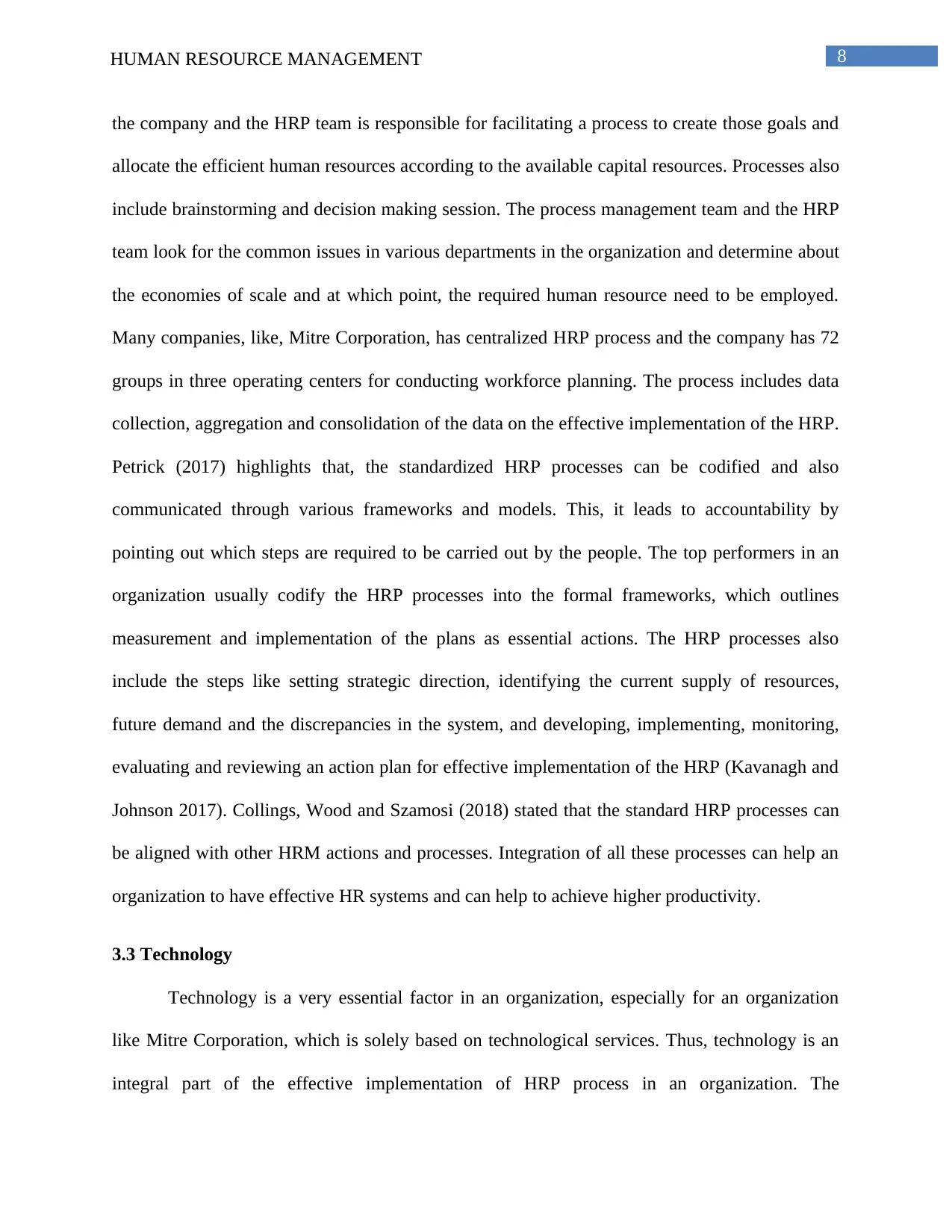
8HUMAN RESOURCE MANAGEMENT
the company and the HRP team is responsible for facilitating a process to create those goals and
allocate the efficient human resources according to the available capital resources. Processes also
include brainstorming and decision making session. The process management team and the HRP
team look for the common issues in various departments in the organization and determine about
the economies of scale and at which point, the required human resource need to be employed.
Many companies, like, Mitre Corporation, has centralized HRP process and the company has 72
groups in three operating centers for conducting workforce planning. The process includes data
collection, aggregation and consolidation of the data on the effective implementation of the HRP.
Petrick (2017) highlights that, the standardized HRP processes can be codified and also
communicated through various frameworks and models. This, it leads to accountability by
pointing out which steps are required to be carried out by the people. The top performers in an
organization usually codify the HRP processes into the formal frameworks, which outlines
measurement and implementation of the plans as essential actions. The HRP processes also
include the steps like setting strategic direction, identifying the current supply of resources,
future demand and the discrepancies in the system, and developing, implementing, monitoring,
evaluating and reviewing an action plan for effective implementation of the HRP (Kavanagh and
Johnson 2017). Collings, Wood and Szamosi (2018) stated that the standard HRP processes can
be aligned with other HRM actions and processes. Integration of all these processes can help an
organization to have effective HR systems and can help to achieve higher productivity.
3.3 Technology
Technology is a very essential factor in an organization, especially for an organization
like Mitre Corporation, which is solely based on technological services. Thus, technology is an
integral part of the effective implementation of HRP process in an organization. The
the company and the HRP team is responsible for facilitating a process to create those goals and
allocate the efficient human resources according to the available capital resources. Processes also
include brainstorming and decision making session. The process management team and the HRP
team look for the common issues in various departments in the organization and determine about
the economies of scale and at which point, the required human resource need to be employed.
Many companies, like, Mitre Corporation, has centralized HRP process and the company has 72
groups in three operating centers for conducting workforce planning. The process includes data
collection, aggregation and consolidation of the data on the effective implementation of the HRP.
Petrick (2017) highlights that, the standardized HRP processes can be codified and also
communicated through various frameworks and models. This, it leads to accountability by
pointing out which steps are required to be carried out by the people. The top performers in an
organization usually codify the HRP processes into the formal frameworks, which outlines
measurement and implementation of the plans as essential actions. The HRP processes also
include the steps like setting strategic direction, identifying the current supply of resources,
future demand and the discrepancies in the system, and developing, implementing, monitoring,
evaluating and reviewing an action plan for effective implementation of the HRP (Kavanagh and
Johnson 2017). Collings, Wood and Szamosi (2018) stated that the standard HRP processes can
be aligned with other HRM actions and processes. Integration of all these processes can help an
organization to have effective HR systems and can help to achieve higher productivity.
3.3 Technology
Technology is a very essential factor in an organization, especially for an organization
like Mitre Corporation, which is solely based on technological services. Thus, technology is an
integral part of the effective implementation of HRP process in an organization. The
⊘ This is a preview!⊘
Do you want full access?
Subscribe today to unlock all pages.

Trusted by 1+ million students worldwide
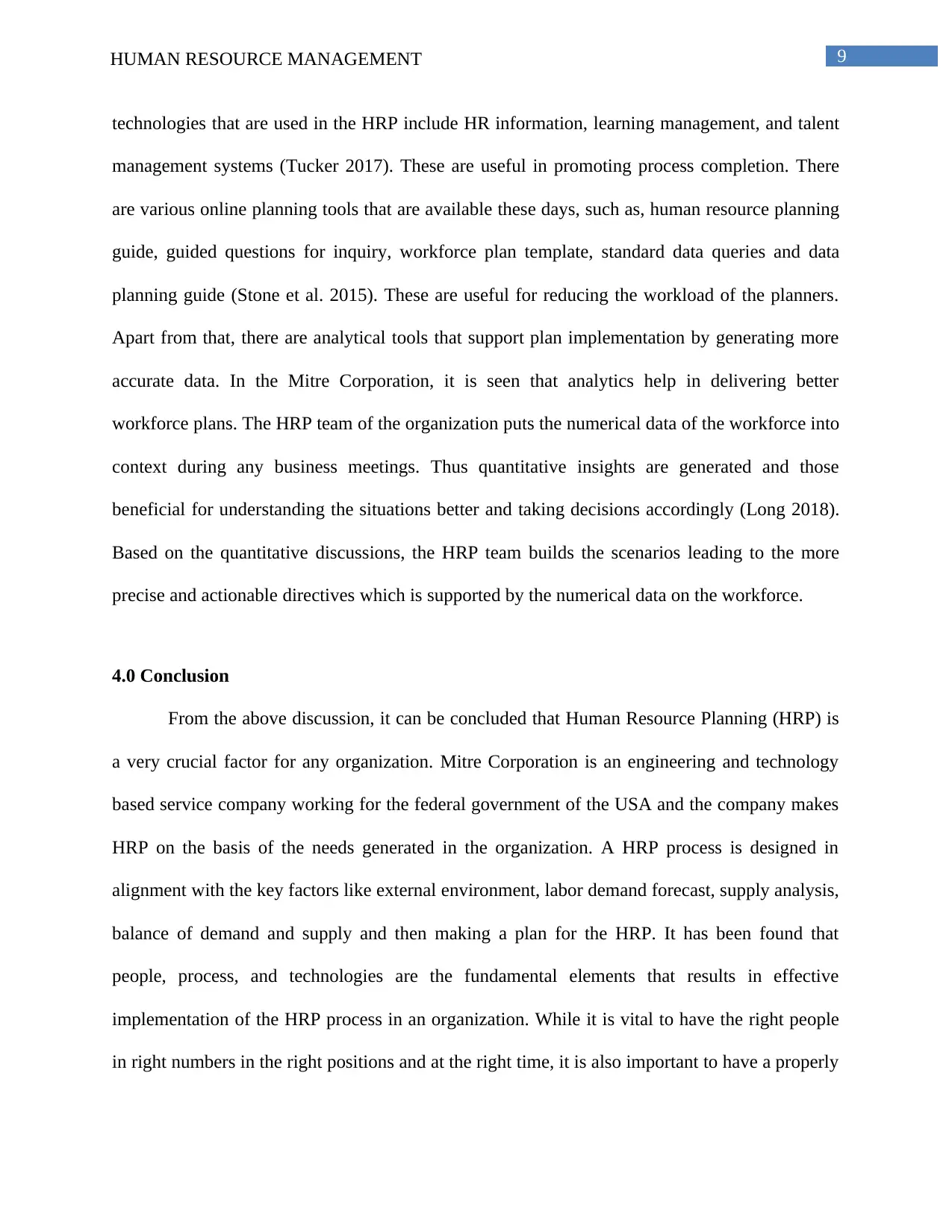
9HUMAN RESOURCE MANAGEMENT
technologies that are used in the HRP include HR information, learning management, and talent
management systems (Tucker 2017). These are useful in promoting process completion. There
are various online planning tools that are available these days, such as, human resource planning
guide, guided questions for inquiry, workforce plan template, standard data queries and data
planning guide (Stone et al. 2015). These are useful for reducing the workload of the planners.
Apart from that, there are analytical tools that support plan implementation by generating more
accurate data. In the Mitre Corporation, it is seen that analytics help in delivering better
workforce plans. The HRP team of the organization puts the numerical data of the workforce into
context during any business meetings. Thus quantitative insights are generated and those
beneficial for understanding the situations better and taking decisions accordingly (Long 2018).
Based on the quantitative discussions, the HRP team builds the scenarios leading to the more
precise and actionable directives which is supported by the numerical data on the workforce.
4.0 Conclusion
From the above discussion, it can be concluded that Human Resource Planning (HRP) is
a very crucial factor for any organization. Mitre Corporation is an engineering and technology
based service company working for the federal government of the USA and the company makes
HRP on the basis of the needs generated in the organization. A HRP process is designed in
alignment with the key factors like external environment, labor demand forecast, supply analysis,
balance of demand and supply and then making a plan for the HRP. It has been found that
people, process, and technologies are the fundamental elements that results in effective
implementation of the HRP process in an organization. While it is vital to have the right people
in right numbers in the right positions and at the right time, it is also important to have a properly
technologies that are used in the HRP include HR information, learning management, and talent
management systems (Tucker 2017). These are useful in promoting process completion. There
are various online planning tools that are available these days, such as, human resource planning
guide, guided questions for inquiry, workforce plan template, standard data queries and data
planning guide (Stone et al. 2015). These are useful for reducing the workload of the planners.
Apart from that, there are analytical tools that support plan implementation by generating more
accurate data. In the Mitre Corporation, it is seen that analytics help in delivering better
workforce plans. The HRP team of the organization puts the numerical data of the workforce into
context during any business meetings. Thus quantitative insights are generated and those
beneficial for understanding the situations better and taking decisions accordingly (Long 2018).
Based on the quantitative discussions, the HRP team builds the scenarios leading to the more
precise and actionable directives which is supported by the numerical data on the workforce.
4.0 Conclusion
From the above discussion, it can be concluded that Human Resource Planning (HRP) is
a very crucial factor for any organization. Mitre Corporation is an engineering and technology
based service company working for the federal government of the USA and the company makes
HRP on the basis of the needs generated in the organization. A HRP process is designed in
alignment with the key factors like external environment, labor demand forecast, supply analysis,
balance of demand and supply and then making a plan for the HRP. It has been found that
people, process, and technologies are the fundamental elements that results in effective
implementation of the HRP process in an organization. While it is vital to have the right people
in right numbers in the right positions and at the right time, it is also important to have a properly
Paraphrase This Document
Need a fresh take? Get an instant paraphrase of this document with our AI Paraphraser
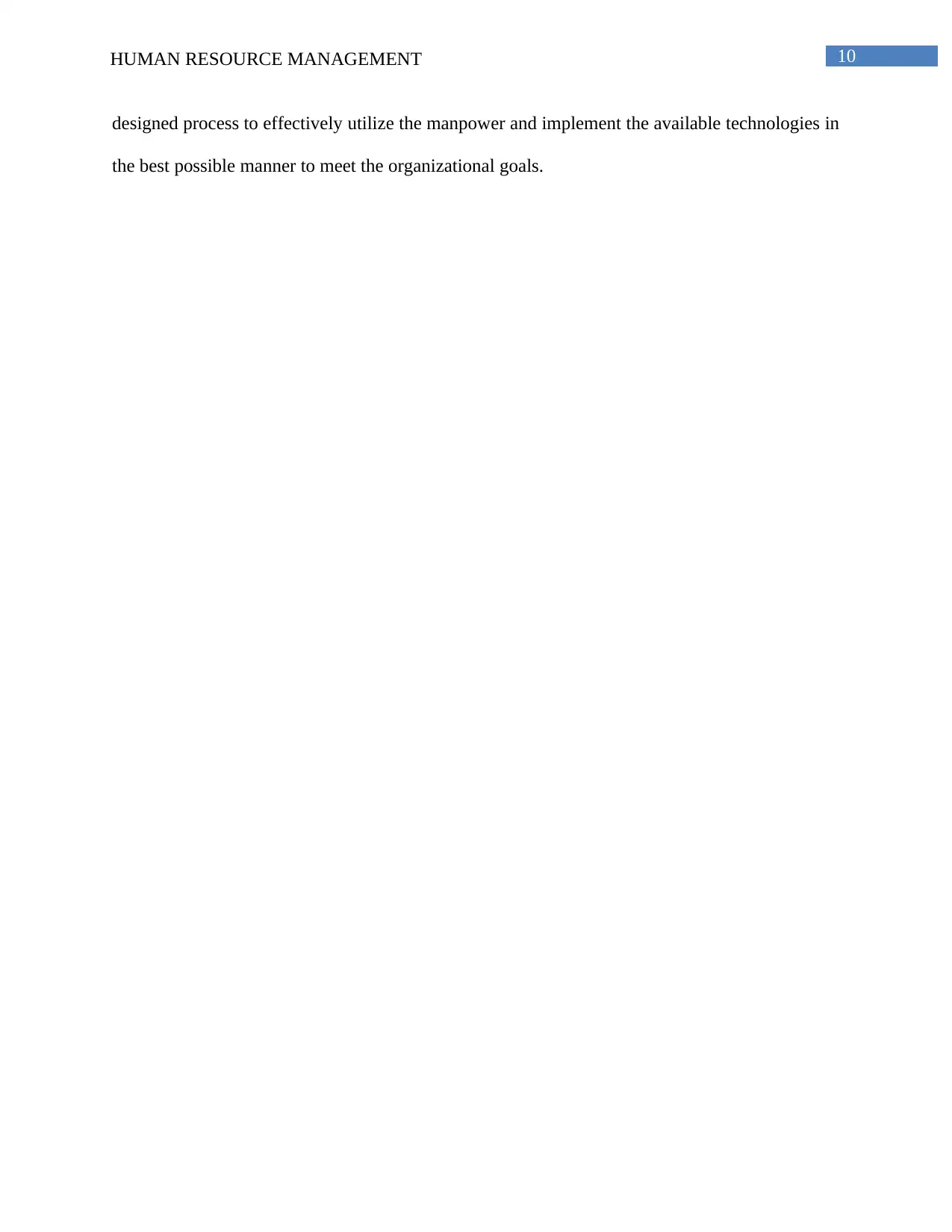
10HUMAN RESOURCE MANAGEMENT
designed process to effectively utilize the manpower and implement the available technologies in
the best possible manner to meet the organizational goals.
designed process to effectively utilize the manpower and implement the available technologies in
the best possible manner to meet the organizational goals.
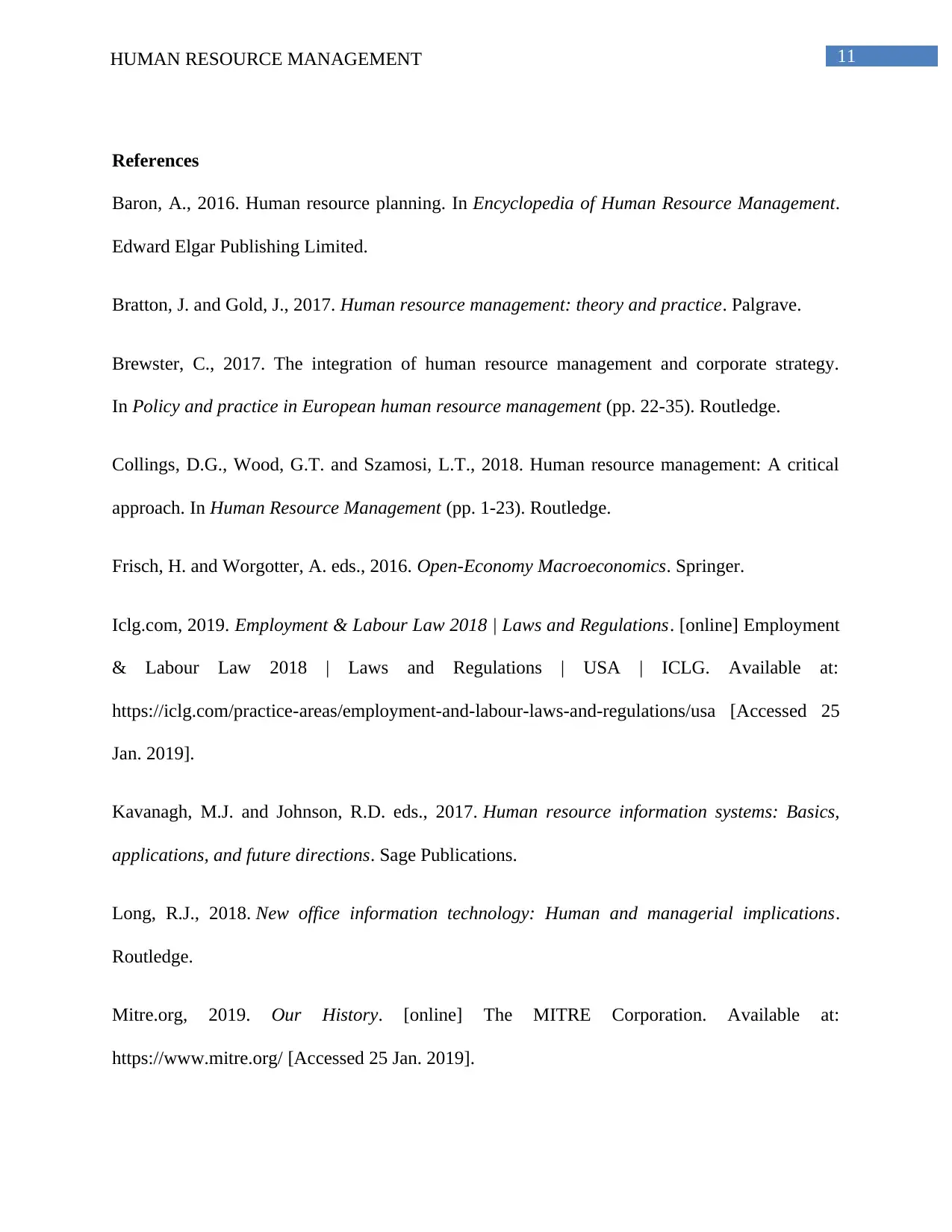
11HUMAN RESOURCE MANAGEMENT
References
Baron, A., 2016. Human resource planning. In Encyclopedia of Human Resource Management.
Edward Elgar Publishing Limited.
Bratton, J. and Gold, J., 2017. Human resource management: theory and practice. Palgrave.
Brewster, C., 2017. The integration of human resource management and corporate strategy.
In Policy and practice in European human resource management (pp. 22-35). Routledge.
Collings, D.G., Wood, G.T. and Szamosi, L.T., 2018. Human resource management: A critical
approach. In Human Resource Management (pp. 1-23). Routledge.
Frisch, H. and Worgotter, A. eds., 2016. Open-Economy Macroeconomics. Springer.
Iclg.com, 2019. Employment & Labour Law 2018 | Laws and Regulations. [online] Employment
& Labour Law 2018 | Laws and Regulations | USA | ICLG. Available at:
https://iclg.com/practice-areas/employment-and-labour-laws-and-regulations/usa [Accessed 25
Jan. 2019].
Kavanagh, M.J. and Johnson, R.D. eds., 2017. Human resource information systems: Basics,
applications, and future directions. Sage Publications.
Long, R.J., 2018. New office information technology: Human and managerial implications.
Routledge.
Mitre.org, 2019. Our History. [online] The MITRE Corporation. Available at:
https://www.mitre.org/ [Accessed 25 Jan. 2019].
References
Baron, A., 2016. Human resource planning. In Encyclopedia of Human Resource Management.
Edward Elgar Publishing Limited.
Bratton, J. and Gold, J., 2017. Human resource management: theory and practice. Palgrave.
Brewster, C., 2017. The integration of human resource management and corporate strategy.
In Policy and practice in European human resource management (pp. 22-35). Routledge.
Collings, D.G., Wood, G.T. and Szamosi, L.T., 2018. Human resource management: A critical
approach. In Human Resource Management (pp. 1-23). Routledge.
Frisch, H. and Worgotter, A. eds., 2016. Open-Economy Macroeconomics. Springer.
Iclg.com, 2019. Employment & Labour Law 2018 | Laws and Regulations. [online] Employment
& Labour Law 2018 | Laws and Regulations | USA | ICLG. Available at:
https://iclg.com/practice-areas/employment-and-labour-laws-and-regulations/usa [Accessed 25
Jan. 2019].
Kavanagh, M.J. and Johnson, R.D. eds., 2017. Human resource information systems: Basics,
applications, and future directions. Sage Publications.
Long, R.J., 2018. New office information technology: Human and managerial implications.
Routledge.
Mitre.org, 2019. Our History. [online] The MITRE Corporation. Available at:
https://www.mitre.org/ [Accessed 25 Jan. 2019].
⊘ This is a preview!⊘
Do you want full access?
Subscribe today to unlock all pages.

Trusted by 1+ million students worldwide
1 out of 14
Related Documents
Your All-in-One AI-Powered Toolkit for Academic Success.
+13062052269
info@desklib.com
Available 24*7 on WhatsApp / Email
![[object Object]](/_next/static/media/star-bottom.7253800d.svg)
Unlock your academic potential
Copyright © 2020–2025 A2Z Services. All Rights Reserved. Developed and managed by ZUCOL.





